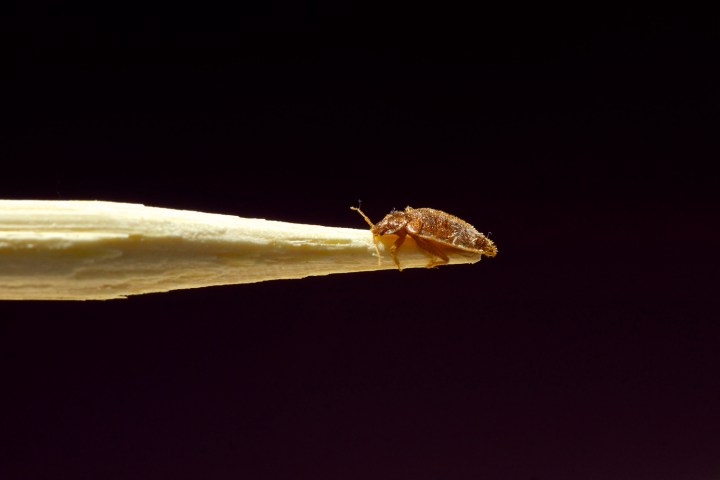
Identify the source

The first thing you should do, before you rush straight into committing mass-insecticide, is identify the culprit. If you’re looking for methods to get rid of bedbugs, it’s probably for a reason. There are several creepy crawlies that can cause bedbug-like symptoms, however, including fleas, scabies, and even spiders. Just to be sure, here’s how to identify if bedbugs are actually the problem.
- Bedbugs are small, dark brown, or purple critters with flat carapaces, usually appearing in bed sheets, mattresses, and furniture. Bed sheets that show signs of bedbug activity will often be stained with tiny blood spots, and the area around their nests will be darkened with brown or black fecal spots. For comparison, fleas tend to be tiny, brown bugs with long bodies. Fleas are smaller than bedbugs, and tend to stay on pets and other animals. However, they have been known to appear on carpets and other upholstery.
- Bedbug bites are itchy, red bumps that often appear in a line, often in groups of three. Depending on the severity of your reaction, the bites may be tiny and itchy; worse cases can bring pain and swelling. Flea bites typically appear in sporadic patterns, all over the affected person (or pet). The reaction to the latter bites can vary in severity, though flea bites can be felt immediately as a minuscule, quick point of pain. Fleas also bite at any time, whereas bedbugs only bite while someone is near their nest (usually at night while sleeping).
If you’ve discovered bedbugs and homed in on their nesting area, your next step is to quarantine.
Quarantine the area
Sectioning off the affected area and items is extremely important, as it will help to stem any further infestation throughout the rest of your room, home, or building. Vacuuming and double bagging items such as bedding, stuffed animals, toys, clothes, linens, and even electronics is imperative. Try throwing some Nuvan insecticide strips into the bags; don’t worry, Nuvan strips won’t ruin your things or leave residual chemicals. Then, leave them sealed for a few days.
Non-chemical treatments
If you’re not down with chemicals, you can also kill bedbugs by freezing them to death. Put your quarantined items in a freezer set to 0 degrees Fahrenheit for four or five days. This should kill a decent number of the bedbugs, and the longer you leave them in your freezer, the more effective the treatment will be.
If cold isn’t your thing, you can use heat to attack the horde of tiny invaders. Try putting your clothing and bedding into plastic trash bags, and then put them in the dryer on high for at least 30 minutes. Like the aforementioned freezer method, the longer the better. Be sure to change out the inner bag, though, and wash your clothes so they aren’t ruined.
As for your bed, vacuum the mattress, box spring, and all pieces of the frame. Full treatment of headboards and bed frames will require professional help. Unless your case is particularly bad, you probably won’t have to discard or destroy any of the affected furniture, especially if you end up seeking professional help. It’s also important to not move to another bed or sleeping area. Despite the temptation, doing so makes it more likely for the bedbugs to spread to your new sleeping area.
If you want to buy new bedding, keep in mind that researchers have found bedbugs have favorite colors: They like dark red and black, while staying away from bright whites. Once you have everything cleaned and vacuumed, you’ll want to keep clothes and clutter off the floor, as these offer places for bedbugs to hide.
Pesticides
Washing, scrubbing, vacuuming, and drying will only get you so far. Whether it’s due to a large number of hard-to-reach nests or the spread of bedbugs to multiple parts of your home, you’ll probably need to use chemicals at some point.
There are many types of pesticides to consider, though. Some take the form of aerosol sprays, while others may function more akin to traps. The important thing is to find EPA-certified pesticides that list bedbugs among the targeted pests and insects. The aforementioned Nuvan strips are just one option. Keep in mind that pesticides can be harmful to humans and pets and may require you to vacate your home for a long period of time in order to work and become inert.
It’s also worth noting that they’ve been shown to be ineffective in many cases. That doesn’t mean they won’t help, and, combined with non-chemical treatments, you may potentially solve your bedbug problem. Still, it’s worth noting.
Professional removal
If you’ve exhausted all other possible strategies, the best course of action is to call a professional extermination service. It can be expensive, sure, but you’ll likely need to rope in a professional if you want to fully eradicate your bedbug problem. Bedbugs generally like to hide in places the layman will be unable to treat, and their eggs are extremely resilient. After enacting your DIY efforts, be sure to thoroughly inspect the infected area for any returning bedbugs. You’re probably fine if you don’t see any after a a few weeks, but if they start showing up again, don’t hesitate to make the call.
Editors' Recommendations
- Narwal’s Freo X Ultra honors reliable, maintenance-free cleaning for 7 weeks
- Nanoleaf gets into the holiday spirit with Matter-enabled string lights
- Smart lock buying guide
- The fall smart home checklist: How to prepare for cooler weather
- Roku gets into the smart home business with Wyze and Walmart






